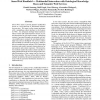AIHC
2007
Springer
14 years 11 months ago
2007
Springer
Many people believe that emotions and subjective feelings are one and the same and that a goal of human-centered computing is emotion recognition. The first belief is outdated; the...
AIHC
2007
Springer
15 years 1 months ago
2007
Springer
Enabling machines to understand emotions and feelings of the human users in their natural language textual input during interaction is a challenging issue in Human Computing. Our w...
AIHC
2007
Springer
15 years 1 months ago
2007
Springer
Automatic multimodal recognition of spontaneous emotional expressions is a largely unexplored and challenging problem. In this paper, we explore audio-visual emotion recognition in...
AIHC
2007
Springer
15 years 1 months ago
2007
Springer
SMARTWEB aims to provide intuitive multimodal access to a rich selection of Web-based information services. We report on the current prototype with a smartphone client interface t...
AIHC
2007
Springer
15 years 1 months ago
2007
Springer
AIHC
2007
Springer
15 years 1 months ago
2007
Springer
Current evaluation methods are inappropriate for emerging HCI applications. In this paper, we give three examples of these applications and show that traditional evaluation method...
AIHC
2007
Springer
15 years 1 months ago
2007
Springer
A widely accepted prediction is that computing will move to the background, weaving itself into the fabric of our everyday living spaces and projecting the human user into the for...
103
click to vote
AIHC
2007
Springer
15 years 1 months ago
2007
Springer
This work addresses the problem of human action recognition by introducing a representation of a human action as a collection of short trajectories that are extracted in areas of ...
AIHC
2007
Springer
15 years 1 months ago
2007
Springer
This paper describes an intelligent system that we developed to support affective multimodal human-computer interaction (AMM-HCI) where the user’s actions and emotions are modele...
152
click to vote
AIHC
2007
Springer
15 years 1 months ago
2007
Springer
Affective and human-centered computing have attracted a lot of attention during the past years, mainly due to the abundance of devices and environments able to exploit multimodal i...






